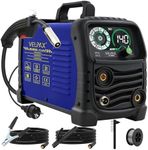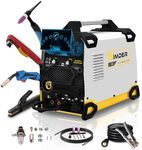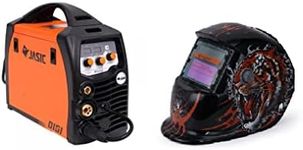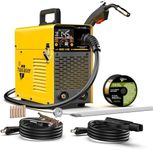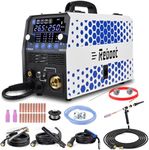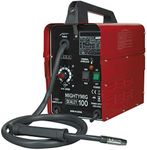Buying Guide for the Best MIG Welders For Beginners
Choosing the right MIG welder as a beginner can be a daunting task, but with the right guidance, you can find a machine that suits your needs and helps you learn effectively. MIG welding is known for its ease of use and versatility, making it a great choice for beginners. When selecting a MIG welder, consider the types of projects you plan to work on, the materials you will be welding, and your future growth as a welder. Understanding the key specifications will help you make an informed decision.Amperage RangeAmperage range refers to the amount of electrical current the welder can produce. This is important because it determines the thickness of the material you can weld. Lower amperage is suitable for thinner materials, while higher amperage is needed for thicker materials. For beginners, a welder with a range of 30-140 amps is usually sufficient for most home and hobby projects. Consider the types of materials you plan to work with and choose a welder that can handle those thicknesses.
Voltage SettingsVoltage settings on a MIG welder control the heat of the arc, which affects the penetration and quality of the weld. Some welders have fixed voltage settings, while others offer variable settings. Beginners may find variable voltage settings more beneficial as they allow for greater control and adaptability to different materials and thicknesses. If you plan to work on a variety of projects, look for a welder with adjustable voltage settings to give you more flexibility.
Duty CycleThe duty cycle of a welder indicates how long it can operate continuously before needing to cool down. It is expressed as a percentage of a 10-minute period. For example, a 20% duty cycle at 90 amps means the welder can run for 2 minutes and then needs an 8-minute rest. A higher duty cycle is beneficial for longer projects or thicker materials. Beginners should consider their project needs; for occasional use, a lower duty cycle may suffice, but for more frequent or intensive use, a higher duty cycle is preferable.
Wire Feed SpeedWire feed speed controls how fast the welding wire is fed into the weld pool. This affects the weld's appearance and strength. Beginners should look for a welder with adjustable wire feed speed to accommodate different materials and welding positions. A welder with a smooth and consistent wire feed is easier to use and will help you achieve better results as you learn.
PortabilityPortability refers to how easy it is to move the welder around. This is important if you plan to work in different locations or have limited space. Portable welders are typically lighter and more compact, making them ideal for beginners who may not have a dedicated workshop. Consider the weight and size of the welder, as well as any handles or wheels that make it easier to transport.
Ease of UseEase of use is crucial for beginners who are just starting to learn welding. Look for features like intuitive controls, clear instructions, and automatic settings that simplify the welding process. Some welders come with beginner-friendly features such as auto-set functions that adjust settings based on material thickness. Choose a welder that you feel comfortable operating and that offers a gentle learning curve.


